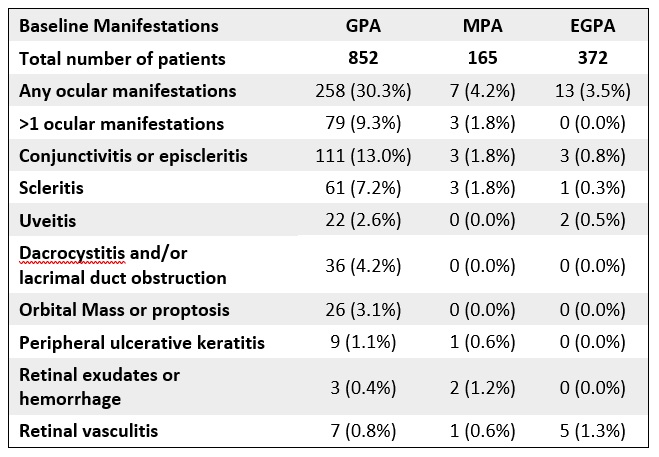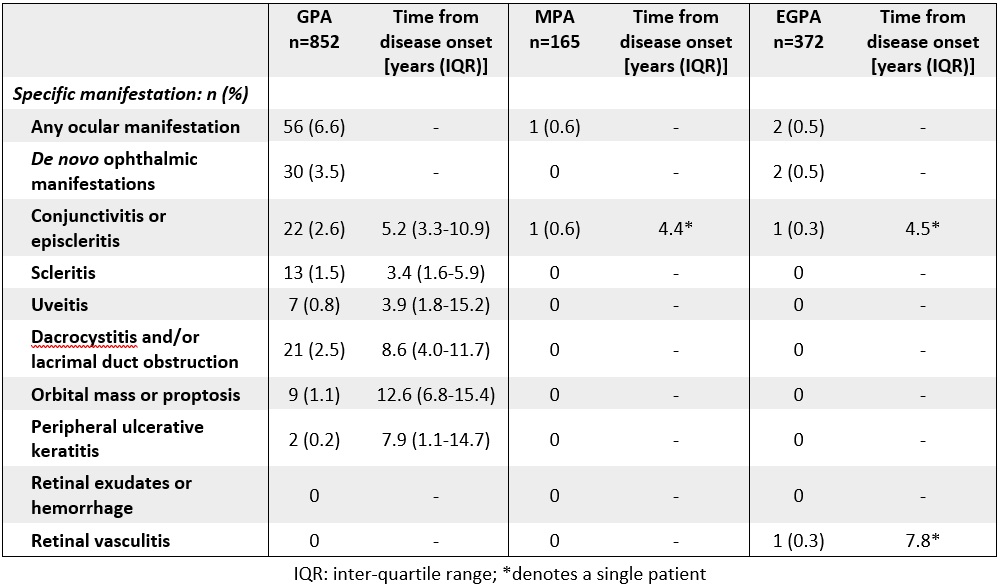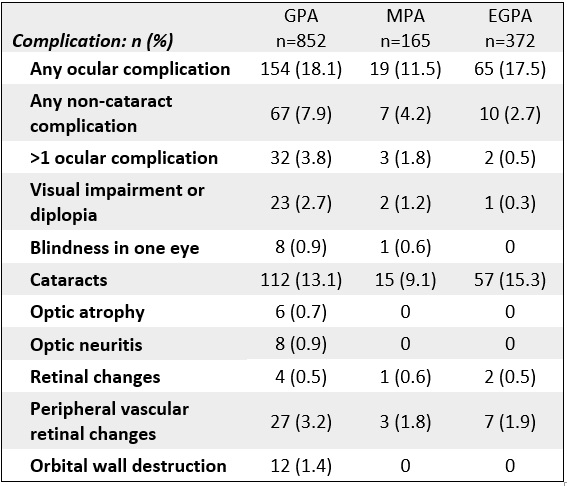Session Information
Session Type: Poster Session A
Session Time: 8:30AM-10:30AM
Background/Purpose: ANCA-associated vasculitides (AAV) are multisystem diseases that can have multiple ophthalmic manifestations. Although there are some data on ocular disease in granulomatosis with polyangiitis (GPA), even less are available for microscopic polyangiitis (MPA) and eosinophilic granulomatosis with polyangiitis (EGPA). Further, there also few reports differentiating symptoms seen at disease onset compared to later in the course of the illness, or whether ophthalmic manifestations are related to other anatomically local disease or systemic manifestations in general.
Methods: Patients with GPA, MPA, or EGPA enrolled in a longitudinal study between April 2006 and April 2021 were included in this study. Data concerning diagnosis, demographics, cranial disease manifestations and their time of onset, treatment, and ocular complications were extracted. Prevalence of ophthalmic manifestations at disease onset and incidence of manifestations over the course of follow up, median time to onset of new manifestations and complications, and correlations with otolaryngologic and neurologic manifestations of disease were calculated.
Results: Data from 1389 patients were included for analysis which included 6392.8 patient-years of follow up. There were 852 cases of GPA, 165 cases of MPA, and 372 cases of EGPA; with 258 (30.3%), 7 (4.2%), and 13 (3.5%) ocular manifestations present at baseline, respectively (Table 1). The most common manifestations seen were conjunctivitis/episcleritis and scleritis, though 38.5% of the ocular manifestations in EGPA were retinal vasculitis. Multiple ophthalmic manifestations were seen in 79 (9.3%) of patients with GPA, and in none with EGPA. In GPA, the prevalence of manifestations was similar when stratified by c-ANCA/PR3 positivity, except for conjunctivitis/episcleritis (p< 0.01). Inflammatory ocular manifestations presented earlier in the disease course (Table 2). During follow up, 6.6% patients with GPA had incident ocular manifestations, while such events were rare in MPA (0.6%) and EGPA (0.5%). There were no significant correlations seen between ophthalmic, otolaryngologic, and neurologic manifestations of disease. The most common complication seen across all 3 diseases was cataracts, seen in 9.1-15.3% of patients. Non-cataract complications followed a similar pattern to other manifestations: 67 (7.9%) patients with GPA experienced such complications followed by 10 (2.7%) of those with EGPA, and 7 (4.2%) of those with MPA (Table 3).
Conclusion: Among patients with AAV, ophthalmic manifestations and complications are common in GPA, but rare in MPA and EGPA. Inflammatory eye conditions are the most common ophthalmic manifestation seen, and cataracts are the most common complication. New ophthalmic manifestations after disease onset are rare. These data are informative for clinicians caring for patients with AAV and investigators studying this spectrum of vasculitis.
To cite this abstract in AMA style:
Junek M, Garner S, Zhao L, Cuthbertson D, Pagnoux C, KOENING C, Langford C, McAlear C, Monach P, Moreland L, Seo P, Specks U, Sreih A, Warrington K, Merkel P, Khalidi N. Ocular Manifestations of ANCA-Associated Vasculitis [abstract]. Arthritis Rheumatol. 2021; 73 (suppl 9). https://acrabstracts.org/abstract/ocular-manifestations-of-anca-associated-vasculitis-2/. Accessed .« Back to ACR Convergence 2021
ACR Meeting Abstracts - https://acrabstracts.org/abstract/ocular-manifestations-of-anca-associated-vasculitis-2/



